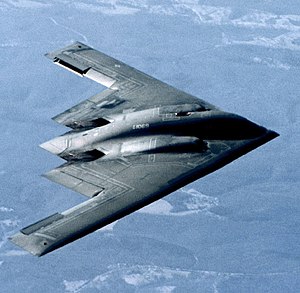John Knudsen Northrop
John Knudsen "Jack" Northrop (born November 10, 1895 in Newark , New Jersey , † February 18, 1981 ) was an American industrialist and aircraft designer.
biography
After his parents moved from Newark, New Jersey to California in 1904, Northrop began his aviation career in 1916 as a design engineer for Loughead Aircraft Manufacturing Company (later Lockheed Corporation ). There he constructed a. a. the wings for the F-1 flying boat and the light aircraft S-1 . After the company became insolvent in 1921, he moved to Douglas Aircraft Company from 1923 to 1926 , where he designed the tank system for the World Cruiser . When the Loughead brothers started a new company in 1926, he returned to Lockheed as chief engineer . There, together with Gerard Vultee, he developed the famous Vega series, with whose aircraft legendary pilots such as Wiley Post and Amelia Earhart set many records.
Northrop founded his first own company, Avion Corporation , in 1928 to conduct experimental studies with load-bearing fuselage sheeting and flying wing designs. The company produced the flying wing EX-1. This made William Boeing aware of Northrop, whereupon Boeing took over the Avion Corporation as the basis for the newly established Northrop Aircraft Corporation . Northrop Aircraft Corporation was part of Boeing's huge United Aircraft and Transport Corporation . The first product was the 1930 Northrop Alpha , the first American aircraft with a load-bearing fuselage skin.
In 1939, the company turned to military design studies , and during World War II built e.g. B. the night fighter P-61 Black Widow .
The development of flying wing aircraft
Northrop dreamed of building an aircraft without a fuselage and tail unit , as this would significantly reduce drag . In the 1940s and 1950s, this vision manifested itself briefly in the YB-35 and YB-49 Flying Wing bombers. Northrop thus inherited Hugo Junkers , who was the first to not only design all-metal airplanes with cantilever wings, but also consistently thought through this idea of a flying wing, but was only able to implement it in technical terms.
In 1910, Junkers had applied for his patent "Glider with a hollow body suitable for holding parts that do not generate lift " in Berlin. In 1914 Junkers also registered this patent in the USA , where after the end of the First World War, like all German patents, it was declared invalid and could be purchased for 5 cents. Junkers also designed various studies on the flying wing. In the Dessau Junkers factories, however, his ideas could only be partially implemented with the G 38 or the Mammut cargo ship, partly for financial and partly for technical reasons .
In the United States designated vincent burnelli his designs RB 1 1920 and RB 2 from 1924, although as a flying wing ( Flying Wings ), but you have to be today Lifting Fuselage rather concept called the floats attribute. An occasionally claimed relationship to the constructions of Junkers with their very thick wings of great depth, which could also accommodate passengers, did not exist.
Northrop's influence on modern aircraft design extends into the 21st century , and his spirit lives on in the B-2 "Spirit" stealth bombers today .
See also
literature
- Kenneth Aitken: Fathers of World Aviation No 7, John Northrop , Airplane Monthly, September 1994.
| personal data | |
|---|---|
| SURNAME | Northrop, John Knudsen |
| ALTERNATIVE NAMES | Northrop, Jack |
| BRIEF DESCRIPTION | American industrialist and aircraft designer |
| DATE OF BIRTH | November 10, 1895 |
| PLACE OF BIRTH | Newark , New Jersey |
| DATE OF DEATH | 18th February 1981 |
